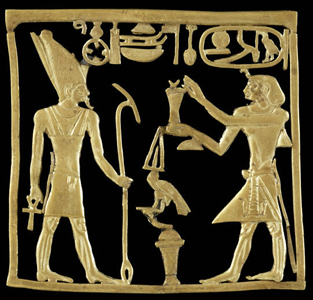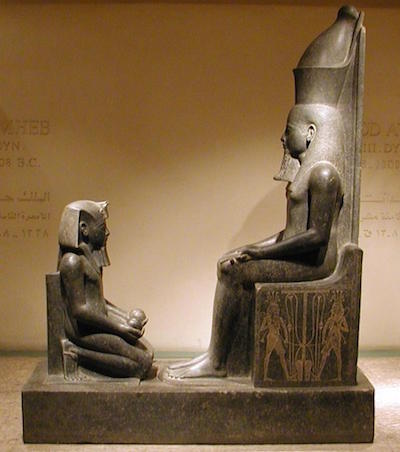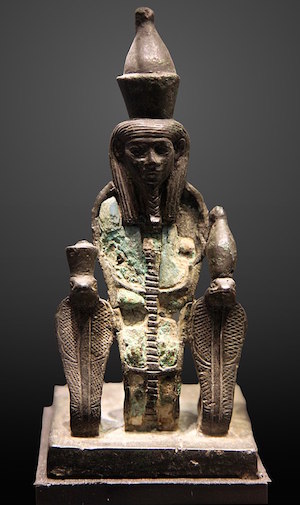
Atum (also known as Tem or Temu) was the first and most important Ancient Egyptian god to be worshiped in Iunu (Heliopolis, Lower Egypt), although in later times Ra rose in importance in the city, and eclipsed him to some extent. He was the main deity of Per-Tem (“house of Atum”) in Pithom in the eastern Delta.
Although he was at his most popular in the Old Kingdom in Lower Egypt, he is often closely associated with the Pharaoh all over Egypt. During the New Kingdom, Atum and the Theban god Montu (Montju) are depicted with the king in the Temple of Amun at Karnak. In the Late Period, amulets of lizards were worn as a token of the god.
Atum was the creator god in the Heliopolitan Ennead. The earliest record of Atum is the Pyramid Texts (inscribed in some of the Pyramids of the Pharaohs of dynasty five and six) and the Coffin Texts (created soon after for the tombs of nobles).

In the beginning there was nothing (Nun). A mound of earth rose from Nun and upon it Atum created himself. He spat Shu (air) and Tefnut (moisture) from his mouth. Atum’s two offspring became separated from him and lost in the dark nothingness, so Atum sent his “Eye” to look for them (a precursor to the “Eye of Ra”, an epithet given to many deities at different times). When they were found, he named Shu as “life” and Tefnut as “order” and entwined them together.
Atum became tired and wanted a place to rest, so he kissed his daughter Tefnut, and created the first mound (Iunu) to rise from the waters of Nun. Shu and Tefnut gave birth to the earth (Geb) and the sky (Nut) who in turn give birth to Osiris, Isis, Set, Nephthys and Horus the elder. In later versions of the myth, Atum produces Shu and Tefnut by masturbation and splits up Geb and Nut because he is jealous of their constant copulation.

His creative nature has two sides. In the Book of the Dead, Atum tells Osiris that he will eventually destroy the world, submerging everything back into the primal waters (Nun), which were all that existed at the beginning of time. In this nonexistence, Atum and Osiris would survive in the form of serpents.
Atum, Ra, Horakhty and Khepri made up the different aspects of the sun. Atum was the setting sun which travelled through the underworld every night. He was also linked with solar theology, as the self-developing scarab who represented the newly created sun. As a result, he is combined with Ra (the rising sun) in both the Pyramid and Coffin Texts as Re-Atum he who “emerges from the eastern horizon” and “rests in the western horizon”. In other words, as Re-Atum he died every night at dusk before resurrecting himself at dawn. In this form, Atum also symbolized the setting sun and its journey through the underworld to its rising in the east.

Atum was the father of the gods, creating the first divine couple, Shu and Tefnut, from whom all the other gods are descended. He was also considered to be the father of the Pharaohs. Many Pharaohs used the title “Son of Atum” long after the power base moved from Iunu. Atum’s close relationship to the king is seen in many cultic rituals, and in the coronation rites. A papyrus dating to the Late period shows that the god was of central importance to the New Year’s festival in which the king’s role was reconfirmed. From the New Kingdom on, he often made an appearance inscribing royal names on the leaves of the sacred ished tree, and in some Lower Egyptian inscriptions Atum is shown crowning the Pharaoh (for example the shrine of Ramesses II in Pithom).
Texts in the New Kingdom tombs of the Valley of the Kings near Thebes depict Atum as an aged, ram-headed man who supervises the punishment of evildoers and the enemies of the sun god. He also repels some of the evil forces in the netherworld such as the serpents Nehebu-Kau and Apep (Apophis). He also provided protection to all good people, ensuring their safe passage past the Lake of Fire where there lurks a deadly dog-headed god who lives by swallowing souls and snatching hearts.
Atum is usually depicted in anthropomorphic form and is typically shown wearing the dual crown of Upper and Lower Egypt. One of the only details that distinguishes him from a Pharaoh is the shape of his beard. He is also depicted with a solar disk and a long tripartite wig.

In his netherworld role, as well as his solar aspect, he is also often presented with the head of a ram. He may be seated on a throne but may also be shown standing erect, or even leaning on a staff when his old age is stressed. Atum was also represented by the image of the primeval hill. During the First Intermediate period “Atum and his Hand” even appear as a divine couple on some coffins. He was represented by the black bull Mnewer, who bore the sun disk and uraeus between its horns. The snake, bull, lion, lizard and ichneumon (Egyptian mongoose) are his sacred animals. As an ape, he was sometimes armed with a bow with which to shoot his enemies. In his aspect as a solar deity, he was also depicted as a scarab and the giant scarab statue which now stands by the sacred lake at Karnak was dedicated to Atum. Also, numerous small bronze coffins containing mummified eels, bearing a figure of the fish on the top of the box and an inscription incised on it, attest to yet another zoomorphic incarnation of Atum.
Representations of Atum are surprisingly rare, but some of the depictions of the Pharaoh as “Lord of the Two Lands” may have also been viewed as incarnations of Atum. The largest of the rare statues of Atum is a group depicting Horemheb of the 18th Dynasty kneeling in front of Atum (above).
Bibliography
- Pinch, Geraldine (2002) Handbook Egyptian Mythology
- Redford Donald B (2002) Ancient Gods Speak
- Strudwick, Nigel and Helen (1999) Thebes in Egypt
- Van De Mieroop, Marc (1999) A History of Ancient Egypt
- Watterson, Barbara (1996) Gods of Ancient Egypt
- Wilkinson, Richard H. (1992) Reading Egyptian Art
- Wilkinson, Richard H. (2003) The Complete Gods and Goddesses of Ancient Egypt
- Wilkinson, Richard H. (2000) The Complete Temples of Ancient Egypt
Copyright J Hill 2008